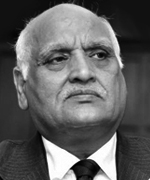Guts, Grit and Glory | Past and Present Connection
 Maj. Gen. Raj Mehta (retd)
Maj. Gen. Raj Mehta (retd)
Mirza Ghalib’s pithy ‘Sau pusht se hai pesha e aaba sipahgari’ (for 100 generations, our profession has been soldiery) phrase may not be entirely applicable to traditionally maritime Gujarat where the sea is never more than a hundred miles (160 km) away from the state’s furthest land boundaries. On the contrary, Gujarat has, since Harappan times, viewed the military as protection for its trade, commerce and prosperity from invaders. Post-Independence, the state has done its bit for national security and now plans to improve its contribution.
History
Human settlement in Gujarat goes back to the Stone Age and there is documented evidence of the later Harappa civilisation that existed over 4,000 years ago. Ruins at Dholavira (Kutch) and Lothal (Kathiawar) reveal a vibrant trading society with military forts such as at Dholavira protecting its trade/commerce.
The known history of Gujarat begins in the 3rd century BCE with the Maurya dynasty, followed by the Shakas, Guptas, Maitrakas, Gurjara-Pratiharas, Solankis and Vaghelas. Many centuries later, in 1299, Alauddin Khilji came to power, followed by Ahmad Shah, who founded Ahmedabad in 1411. The Mughal rule continued in Gujarat till the British took over. Throughout forts were necessary to protect trade and commerce, and today, ruins of many such forts can be found in Gujarat. For instance, the Solanki Fort near Baroda, the marvellously restored Surat Fort built by Khudawand Khan in 1546 to protect India’s strategic western gateway, Surat Port — then the world’s richest port — from invading hordes, are some of the glorious instances.
Today, Gujarat, with its 1,596-km coastline, encompasses the Kathiawar Peninsula (Saurashtra), Kutch as well as surrounding areas on the mainland. Bounded by Pakistan, Rajasthan, Madhya Pradesh and Maharashtra, Gujarat also shares borders with the Union Territory of Dadra and Nagar Haveli and surrounds the territory of Daman and Diu. Earlier part of Bombay State, Gujarat came into existence in 1960 after being separated from Maharashtra. Its diverse population includes Rajputs, Muslims, Parsis and ethnic tribes.
1
Princely States
Gujarat’s vast medley of 435 princely states have been around for ages, with Bhavnagar, for instance, dating back to 1240, Palanpur to the early 14th century, Rajpipla to 1460 and Baroda to the 17th century. During the British Raj, 18 of these princely states were ‘salute states’ of which Baroda was accorded a hereditary salute of 21 guns (along with Patiala and Hyderabad). Some other important gun states were Idar, Bhavnagar, Jamnagar (Navanagar), Dhrangadhra-Halvad, Porbandar, Rajpipla, Morvi, Baria, Dharampur, Limbdi and Rajkot.
As per eminent scholar K.K. Shastri, the warrior castes in the erstwhile princely states were Chavadas, Chauhans, Chudasamas, Gohilas, Jadejas, Jhalas, Parmars, Rathods, Rehyars, Sarvaiyas, Sisodias, Solankis, and Vaghelas. There were also local groups/ tribes like Mhers and Rabaris (Porbandar), Patanwadia Kolis (Kutch/Mahi River), Meenas and Sodhas (Kutch), Kolis who were spread all over and Jhuts (North Gujarat). While Gujaratis were enlisted as soldiers, sol
Subscribe To Force
Fuel Fearless Journalism with Your Yearly Subscription
SUBSCRIBE NOW
We don’t tell you how to do your job…
But we put the environment in which you do your job in perspective, so that when you step out you do so with the complete picture.








